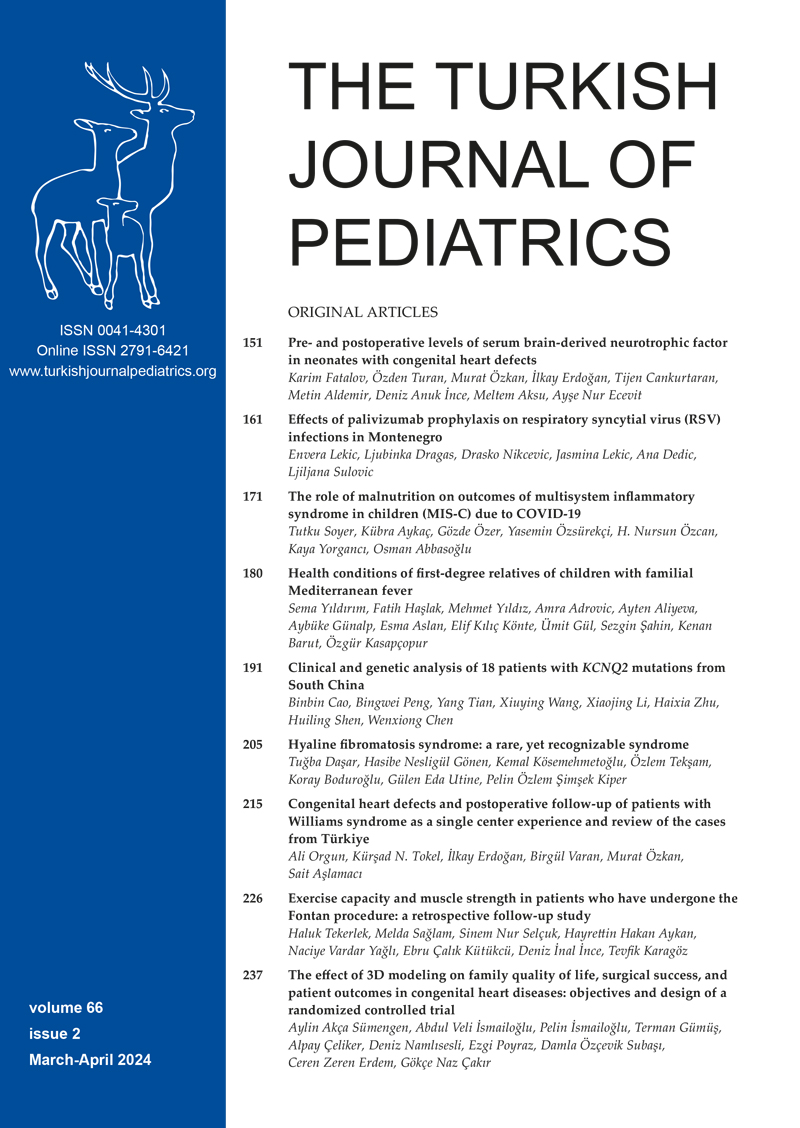Abstract
Background. Hyaline fibromatosis syndrome is a rare autosomal recessive disorder caused by ANTXR2 pathogenic variants. The disorder is characterized by the deposition of amorphous hyaline material in connective tissues. The hallmarks of the disease are joint contractures, generalized skin stiffness, hyperpigmented papules over extensor surfaces of joints, fleshy perianal masses, severe diarrhea, and gingival hypertrophy. The severity of the disease varies and prognosis is poor. No specific treatment is yet available. Most patients with the severe form of the condition pass away before the second year of age. In this study, we describe the clinical and molecular findings of a cohort of seven hyaline fibromatosis syndrome patients who were diagnosed and followed up at a single tertiary reference center in Turkey.
Methods. Genomic DNA was extracted by standard salting out method from peripheric blood samples of three patients. In one patient DNA extraction was performed on pathology slides since peripheric blood DNA was not available. All coding exons of the ANTXR2 were amplified and sequenced on ABI Prism 3500 Genetic Analyser.
Results. Sanger sequencing was performed in 3 patients and homozygous c.945T>G p.(Cys315Trp), c.1073dup p.(Ala359CysfsTer13), and c.1074del p.(Ala359HisfsTer50) variants were identified in ANTXR2. All patients passed away before the age of five years.
Conclusions. HFS is a rare, progressive disorder with a broad phenotypic spectrum. HFS can be recognized easily with distinctive clinical features. Nevertheless, it has poor prognosis with increased mortality due to severe clinical decompensation.
Keywords: Hyaline Fibromatosis Syndrome, juvenile hyaline fibromatosis, infantile systemic hyalinosis, ANTXR2, CMG2
References
- Shieh JTC, Hoyme HE, Arbour LT. Hyaline fibromatosis syndrome. 2008 Feb 27 [updated 2023 May 11]. In: Adam MP, Feldman J, Mirzaa GM, et al., editors. GeneReviews® [Internet] Seattle (WA) University of Washington, Seattle; 1993-2023.
- Casas-Alba D, Martínez-Monseny A, Pino-Ramírez RM, et al. Hyaline fibromatosis syndrome: clinical update and phenotype-genotype correlations. Hum Mutat 2018; 39: 1752-1763. https://doi.org/10.1002/humu.23638
- Nofal A, Sanad M, Assaf M, et al. Juvenile hyaline fibromatosis and infantile systemic hyalinosis: a unifying term and a proposed grading system. J Am Acad Dermatol 2009; 61: 695-700. https://doi.org/10.1016/j.jaad.2009.01.039
- Hanks S, Adams S, Douglas J, et al. Mutations in the gene encoding capillary morphogenesis protein 2 cause juvenile hyaline fibromatosis and infantile systemic hyalinosis. Am J Hum Genet 2003; 73: 791-800. https://doi.org/10.1086/378418
- Cozma C, Hovakimyan M, Iurașcu MI, et al. Genetic, clinical and biochemical characterization of a large cohort of patients with hyaline fibromatosis syndrome. Orphanet J Rare Dis 2019; 14: 209. https://doi.org/10.1186/s13023-019-1183-5
- Richards S, Aziz N, Bale S, et al. Standards and guidelines for the interpretation of sequence variants: a joint consensus recommendation of the American College of Medical Genetics and Genomics and the Association for Molecular Pathology. Genet Med 2015; 17: 405-424. https://doi.org/10.1038/gim.2015.30
- Dowling O, Difeo A, Ramirez MC, et al. Mutations in capillary morphogenesis gene-2 result in the allelic disorders juvenile hyaline fibromatosis and infantile systemic hyalinosis. Am J Hum Genet 2003; 73: 957-966. https://doi.org/10.1086/378781
- Abrami L, Kunz B, van der Goot FG. Anthrax toxin triggers the activation of src-like kinases to mediate its own uptake. Proc Natl Acad Sci U S A 2010; 107: 1420-1424. https://doi.org/10.1073/pnas.0910782107
- Friebe S, van der Goot FG, Bürgi J. The ins and outs of anthrax toxin. Toxins (Basel) 2016; 8: 69. https://doi.org/10.3390/toxins8030069
- Zhu Y, Du X, Sun L, Wang H, Wang D, Wu B. Hyaline fibromatosis syndrome with a novel 4.41-kb deletion in ANTXR2 gene: a case report and literature review. Mol Genet Genomic Med 2022; 10: e1993. https://doi.org/10.1002/mgg3.1993
- Gao Y, Bai J, Wang J, Liu X. Two novel mutations in the ANTXR2 gene in a Chinese patient suffering from hyaline fibromatosis syndrome: a case report. Mol Med Rep 2018; 18: 4004-4008. https://doi.org/10.3892/mmr.2018.9421
- Bürgi J, Kunz B, Abrami L, et al. CMG2/ANTXR2 regulates extracellular collagen VI which accumulates in hyaline fibromatosis syndrome. Nat Commun 2017; 8: 15861. https://doi.org/10.1038/ncomms15861
- Deuquet J, Lausch E, Guex N, et al. Hyaline fibromatosis syndrome inducing mutations in the ectodomain of anthrax toxin receptor 2 can be rescued by proteasome inhibitors. EMBO Mol Med 2011; 3: 208-221. https://doi.org/10.1002/emmm.201100124
- Murray J. On three peculiar cases of molluscum fibrosum in children in which one or more of the following conditions were observed: hypertrophy of the gums, enlargement of the ends of the fingers and toes, numerous connecive-tissue tumours on the scalp. Med Chir Trans 1873; 56: 235-254.
- Denadai R, Raposo-Amaral CE, Bertola D, et al. Identification of 2 novel ANTXR2 mutations in patients with hyaline fibromatosis syndrome and proposal of a modified grading system. Am J Med Genet A 2012; 158A: 732-742. https://doi.org/10.1002/ajmg.a.35228
- El-Kamah GY, Mostafa MI. Heterogeneity and atypical presentation in infantile systemic hyalinosis with severe labio-gingival enlargement: first Egyptian report. Dermatol Online J 2009; 15: 6.
- Shin HT, Paller A, Hoganson G, Willner JP, Chang MW, Orlow SJ. Infantile systemic hyalinosis. J Am Acad Dermatol 2004; 50: S61-S64. https://doi.org/10.1016/s0190-9622(03)02798-1
- Al Sinani S, Al Murshedy F, Abdwani R. Infantile systemic hyalinosis: a case report with a novel mutation. Oman Med J 2013; 28: 53-55. https://doi.org/10.5001/omj.2013.12
Copyright and license
Copyright © 2024 The Author(s). This is an open access article distributed under the Creative Commons Attribution License (CC BY), which permits unrestricted use, distribution, and reproduction in any medium or format, provided the original work is properly cited.















